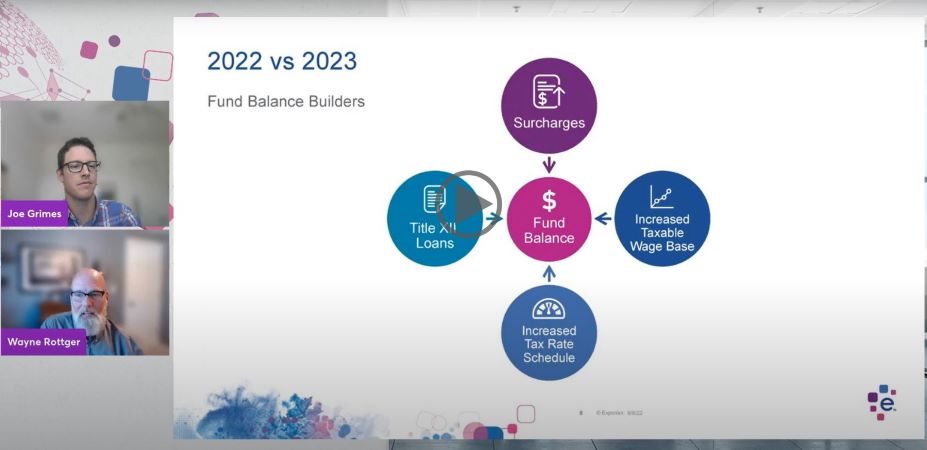Unemployment
Get up-to-date guidance on every aspect of unemployment tax compliance and establish strategies for reducing unemployment costs.

Employment and income verification, unemployment management, year-end tax forms and more from a single provider improves the employee experience.

Learn more about UI employer liability and employee eligibility in Illinois to stay compliant with both state and federal regulations and reduce unnecessary costs.

This webinar provides best practices for projecting your future UI tax rate and how to adapt to a new tax landscape changed by the COVID-19 pandemic.

A FUTA credit reduction is imminent in these states for 2023, which would mean higher taxes for employers operating in these jurisdictions.

State governments primarily pay out unemployment benefits funded by specific taxes collected for that purpose. Given that navigating through state unemployment programs presents many challenges, we have created a blog series outlining some of the specifics, such as employer liability, employee eligibility, benefit levels and duration in different states. Unemployment Insurance in Texas The Texas Workforce Commission (TWC) administers the UI program in Texas. The Texas Unemployment Tax Act (TUCA) establishes the provisions of the UI system in Texas, defines employment and establishes which types of employers participate in the unemployment tax system. Employers who meet requirements for UI employer liability in Texas are required by law to participate in the Texas state unemployment tax program. Liable employers must report employee wages and pay the unemployment tax based on the TUCA. Employers covered by UI employer liability in Texas include: Sole proprietorships; Partnerships; Limited Liability Companies (LLC); Professional Limited Liability Companies (PLLC); Limited Partnerships (LP); Limited Liability Partnerships (LLP); Professional Corporations (PC); Professional Associations (PA); corporations and foundations; Associations; Trusts; Estates; Banking institutions; Political subdivisions; and Government agencies. UI employer liability in Texas differs for different types of employment and TWC uses three employment categories: regular, domestic and agricultural. Regular Employment Under any of the following circumstances, employers meet requirements for UI employer liability in Texas if they: Have Texas employees and are subject to the Federal Unemployment Tax Act (FUTA) in Texas or another state; Pay at least $1,500 in total gross wages to employees in any calendar quarter; Pay at least one employee for a minimum of one hour a day during 20 different weeks in a calendar year; Have been designated as a 501(c)(3) organization by the IRS and have at least four full- or part-time employees for 20 different weeks in a calendar year; or Acquire or take over, through any means, the total or partial assets of a business, trade, organization or workforce that is liable for the UI tax. Domestic Employers Under any of the following circumstances, employers meet requirements for UI employer liability in Texas if they: Pay $1,000 or more in total gross wages in a calendar quarter; or Take over the domestic employees from another household that is liable for the UI tax. Agricultural Employment Under any of the following circumstances, employers meet requirements for UI employer liability in Texas if they: Employ at least three employees for a minimum of one hour a day for 20 weeks in a calendar year; Pay at least $6,250 in total gross cash wages to employees in a calendar quarter; Employ a seasonal worker on a truck farm, orchard or vineyard; Employ a migrant or seasonal worker who works for a farmer, ranch operator or labor agent; or Acquire or take over, through any means, the total or partial assets of the business, trade, organization or workforce that is liable for the UI tax. UI Employee Eligibility in Texas TWC evaluates eligibility for unemployment benefits claim based on: Past wages; Job separation; and Ongoing eligibility requirements. To qualify for UI employee eligibility in Texas, employees have to meet requirements in each of these three areas. Past Wages Past wages are one of the requirements for UI employee eligibility in Texas that also serves as the basis of potential unemployment benefit amounts. TWC uses the taxable wages, earned in Texas, that employers have reported during the base period to calculate unemployment benefits. The base period is the first four of the last five completed calendar quarters before the effective date of the initial claim. To have a payable claim, employees must meet the following requirements: They have wages in more than one of the four base period calendar quarters; Their total base period wages are at least 37 times their weekly benefit amount; and If they qualified for benefits on a prior claim, they must have earned six times their new weekly benefit amount since that time. Job Separation To meet the requirements for UI employee eligibility in Texas based on job separation, employees must be either unemployed or working reduced hours through no fault of their own. Examples include layoff, reduction in hours or wages not related to misconduct, being fired for reasons other than misconduct, or quitting with good cause related to work. Ongoing Eligibility Requirements In addition to the past wages and job separation, there are requirements for UI employee eligibility in Texas that employees must continue to meet. To do so, employees must be totally or partially unemployed and meet all of the following conditions: Meet all work search requirements, unless TWC exempts employees from work search; Request payment for weeks of unemployment, when scheduled; Be physically and mentally able to work; Be available for full-time work; Participate in reemployment activities as required; and Respond to requests from TWC or a Workforce Solutions office as instructed. Reducing Unemployment Costs Employers have several things to keep in mind when it comes to paying taxes. Understanding unemployment insurance and how unemployment claims can affect their tax rates is one of many challenges that employers have to overcome. Given that each claim assessed to an employer’s account can lead to a tax rate increase in future years, they should take all the necessary steps to reduce their unemployment costs. While determining whether former employees are eligible for unemployment benefits or going through the hassle of fighting unemployment claims is complex and time-consuming, employers need to prevent UI benefit charges to keep their unemployment tax rate low. To simplify this process and reduce the overall expenses, employers can use an efficient software tool to manage their unemployment costs. This allows them to significantly improve every aspect of managing unemployment claims, consolidate relevant UI information for better decision making, gain access to more accurate and timely data to improve business processes, work with knowledgeable unemployment tax professionals and rely on their expertise. To simplify this process and reduce the overall expenses, employers can use an efficient software tool to manage their unemployment costs. This allows them to significantly improve every aspect of managing unemployment claims, consolidate relevant UI information for better decision making, gain access to more accurate and timely data to improve business processes, work with knowledgeable unemployment tax professionals and rely on their expertise.

Learn about different aspects of California UI tax to stay compliant, control UI costs and reduce the risk of incurring unnecessary penalties.

Learn about the common reasons for unemployment insurance overpayments and measures that states take to reduce and prevent them.

Learn more about reemployment tax liability and employee eligibility in Florida to stay compliant with the necessary regulations and prevent potential costs.

Get an overview of the UI Integrity Act and recent actions taken to reduce improper payments to prepare and ensure UI integrity compliance.

Learn more about UI employer liability and employee eligibility in New Jersey to stay compliant with the necessary regulations and reduce potential costs.

Learn more about UI employer liability and employee eligibility in the state of New York to stay compliant with the necessary regulations.

Learn about the amount of 2022 unemployment benefits in different states and recent amendments to state unemployment programs to stay up to date.

Learn more about the State Information Data Exchange System program and different SIDES benefits allowing you to ensure effective unemployment claims management.